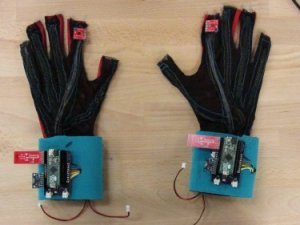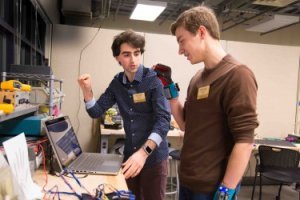
These “SignAloud” gloves developed by UW sophomores Navid Azodi and Thomas Pryor translate American Sign Language into speech and text.University of Washington
Their invention, «SignAloud," is a pair of gloves that can recognize hand gestures that correspond to words and phrases in American Sign Language. Each glove contains sensors that record hand position and movement and send data wirelessly via Bluetooth to a central computer. The computer looks at the gesture data through various sequential statistical regressions, similar to a neural network. If the data match a gesture, then the associated word or phrase is spoken through a speaker.
They honed their prototype in the UW CoMotion MakerSpace — a campus space that offers communal tools and equipment and opportunities for students to tinker, create and innovate. For Azodi and Pryor, that meant finding a way to translate American Sign Language into a verbal form instantaneously and in an ergonomic fashion.
«Many of the sign language translation devices already out there are not practical for everyday use. Some use video input, while others have sensors that cover the user’s entire arm or body," said Pryor, an undergraduate researcher in the Composite Structures Laboratory in the Department of Aeronautics & Astronautics and software lead for the Husky Robotics Team.
«Our gloves are lightweight, compact and worn on the hands, but ergonomic enough to use as an everyday accessory, similar to hearing aids or contact lenses," said Pryor.

Navid Azodi (left) and Thomas Pryor (right) refine their SignAloud system in the UW CoMotion MakerSpace, where they developed the award-winning technology.University of Washington
«Our purpose for developing these gloves was to provide an
The team received support and mentoring from Mike Clarke, who manages the CoMotion MakerSpace and met the students after one asked for help with some soldering equipment that turned out to be broken.
«We disassembled it and fixed it together while talking about their sign language translation project. I recognized from working and talking with Thomas and Navid that they were standouts and that the invention they made was really impressive," Clarke said.
Pryor and Azodi’s first target audience is the deaf and
Their «Use It» Student Prize is one of seven awarded by the
«This year’s
Source: http://www.washington.edu/news/2016/04/12/uw-undergraduate-team-wins-10000-lemelson-mit-student-priz...


